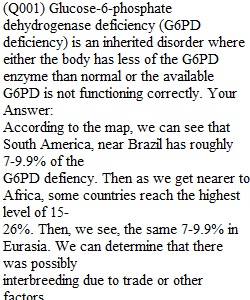


Q Question 1 1 / 1 pts (Q001) Glucose-6-phosphate dehydrogenase deficiency (G6PD deficiency) is an inherited disorder where either the body has less of the G6PD enzyme than normal or the available G6PD is not functioning correctly. This deficiency affects red blood cell function and may result in anemia (the destruction of red blood cells) when people with the condition have infections, are taking certain medications, or eat certain foods. People with G6PD deficiency may have some protection from malaria because their abnormal red blood cells interfere with the reproduction of the malaria parasite in their bodies. Consider the prevalence of G6PD deficiency estimated by the World Health Organization (WHO) as shown in the map on p. 247 of your lab manual (Lab 08 Exercise 7). Compare the distribution of G6PD deficiency with the distributions of the sickle-cell trait and malaria shown in Figure 8.9 ("Distributions of Sickle-Cell Trait and Malaria in Africa") on p. 238 of your lab manual. What similarities between these distributions do you notice? What differences do you notice? Question 2 1 / 1 pts (Q002) Why might these similarities and differences exist? Be sure to consider the evolutionary context (including the natural environment, cultural practices, and interbreeding).
View Related Questions